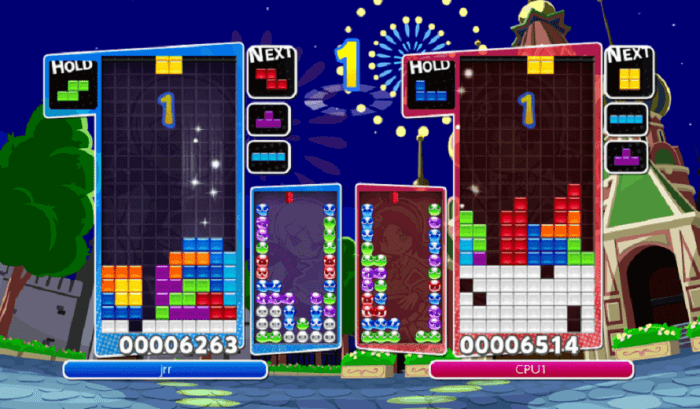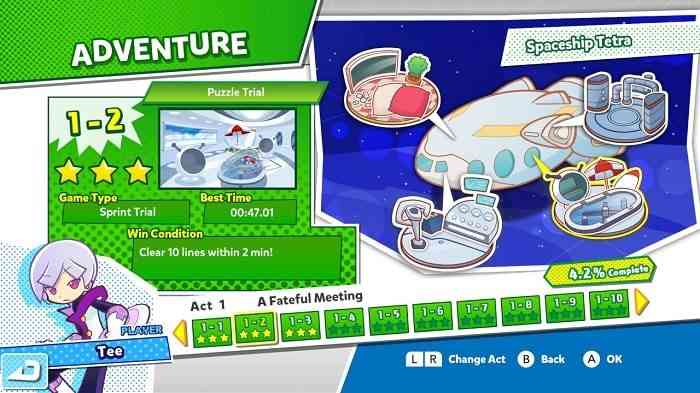Puyo Puyo Tetris Review
In the pantheon of timeless video game franchises, there are few that are as hard to screw up as Tetris and Puyo Puyo (or Kirby’s Avalanche, for you arcade purists). They are both well-respected torchbearers of the puzzle game genre, and the fact that people of all ages still lovingly play them is proof of their flawless formulas. Of course, that hasn’t stopped numerous developers from making a plethora of iterations to the basal ganglia of each game, adding new bells and whistles to varying degrees of success.
In that respect, Puyo Puyo Tetris takes a unique approach to modifying these games. Instead of trying to think up new ways to play each one, Sonic Team has opted to design modes that fuse the base formulas together and wrap those modes within a vibrant and cheerful aesthetic. While you can squeeze some fun out of a couple of these, they are also unintuitive in many ways, and the game fails to prove that Tetris and Puyo Puyo actually work all that well together.
__________________________
“…the game fails to prove that Tetris and Puyo Puyo actually work all that well together.”
Considering Tetris is arguably the most popular video game in history it shouldn’t need much explanation. A randomly assorted series of pre-set shapes fall from the top of the screen and need to be aligned into straight lines in order to be cleared. Puyo Puyo, however, may be less familiar to Western audiences who haven’t touched games like Kirby’s Avalanche. In Puyo Puyo Tetris, color-coded blobs, called Puyo, fall in twos, and you must match four blobs of the same colour to “pop” them. Much like Tetris, the premise sounds simple, but getting the highest score requires arranging the blobs so you can chain together a large sequence of popping Puyos in combination.

I can understand why Sonic Team would attempt to merge these two playstyles into an entertaining hybrid, yet it didn’t take long to realize that they simply don’t mix well. On the surface, they don’t seem that different, but they have painfully conflicting pacing thanks to the nuances unique to each style. Tetris is a frenetic race to build up your bricks and clear as many lines at once as possible. Puyo Puyo is a much slower and more deliberate affair, requiring you to plan out how you’ll lay down intricate, interlocking piles of colored blobs to trigger huge chain reactions.
The incongruous pacing most of the game’s five new modes difficult to enjoy, if not entirely frustrating. A few of them, like vanilla Versus and the power-up-heavy Party Mode, lets players pick between Puyo Puyo and Tetris, which makes the experience less fun if each player chooses a different game. There’s also Big Bang, which presents you and your opponent with a series of single-screen puzzles to solve as quickly as possible. While the Puyo Puyo side of this mode is challenging enough, the Tetris puzzles are far too simple to keep you coming back after your first few matches.
The most impractical of those modes, however, is Fusion mode, which often plays like it was designed to combine the two playstyles in the most frustrating way possible. In this amalgamation, falling pieces switch between tetriminos and puyos as they drop, Puyos can change colors at will, and frustratingly, once a tetrimino touches anything on the board, it can’t be moved. This constant switching makes it impossible to play either game effectively; it prevents you from setting up large combos with puyos, and because tetriminos can’t be moved once they touch something, they can’t be slid into an open slot beneath a block like you can in regular Tetris. So if your first tetrimino is an S or a Z, for example, you’re already starting at a disadvantage. By merging the two games in this way, the mode completely disregards the things that make either game fun on their own.
_________________________
“By merging the two games in this way, the mode completely disregards the things that make either game fun on their own.”
Along with these five modes, six challenge levels and tutorials, Puyo Puyo Tetris also features a 100-level Adventure mode that is staggeringly arduous. I didn’t go into this mode with the highest of expectations, but I wasn’t prepared for just how annoying it would even at level 1-1. It’s a nice idea on paper: a series of increasingly difficult levels that teach you the mechanics of each mode, wrapped within a “Saturday Morning Cartoon”-esque narrative and aesthetic. That art style gives the mode, and the entire game, a vibrant and charming quality, and completing each level unlocks new backgrounds and new art styles for the puyos and tetriminos.
Unfortunately, the story makes zero sense, even for a cartoon, with characters that have less dimension than their 2D models and voice acting that can only be described a “painful’. Many of these characters are cameos from previous Puyo Puyo games, which makes them even less meaningful if you are unfamiliar with the franchise.

At the end of my time with Puyo Puyo Tetris, I was left wondering just who exactly this game is for. Diehard fans of Tetris and Puyo Puyo who are looking for a way to play them can find much cleaner and more fun versions of either one on Steam, their consoles, or even their mobile phones. The game’s new modes don’t merge either playstyle together well enough to justify any of them, and I can’t imagine they are easy enough to appeal to the child demographic that the game’s aesthetic and adventure mode are clearly aimed towards. While the multiplayer may offer some friendly competition for a family with young children, there are better options out there for that, as well. Sonic Team tried to bring together two franchises as classic as peanut butter and/or chocolate, separately. But in combination, they mix about as well as oil and water.
**PC key provided by the publisher**
The Good
- Tetris and Puyo Puyo each play well
- Great style and aesthetics
- Tons of unlockables
The Bad
- Poorly written
- Grating voice acting
- Tetris and Puyo combine poorly

